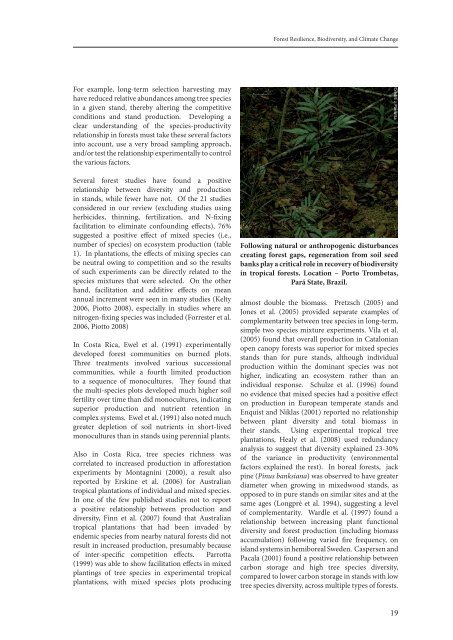Forest Resilience, Biodiversity, and Climate Change
Forest Resilience, Biodiversity, and Climate Change
Forest Resilience, Biodiversity, and Climate Change
You also want an ePaper? Increase the reach of your titles
YUMPU automatically turns print PDFs into web optimized ePapers that Google loves.
<strong>Forest</strong> <strong>Resilience</strong>, <strong>Biodiversity</strong>, <strong>and</strong> <strong>Climate</strong> <strong>Change</strong>For example, long-term selection harvesting mayhave reduced relative abundances among tree speciesin a given st<strong>and</strong>, thereby altering the competitiveconditions <strong>and</strong> st<strong>and</strong> production. Developing aclear underst<strong>and</strong>ing of the species-productivityrelationship in forests must take these several factorsinto account, use a very broad sampling approach,<strong>and</strong>/or test the relationship experimentally to controlthe various factors.Several forest studies have found a positiverelationship between diversity <strong>and</strong> productionin st<strong>and</strong>s, while fewer have not. Of the 21 studiesconsidered in our review (excluding studies usingherbicides, thinning, fertilization, <strong>and</strong> N-fixingfacilitation to eliminate confounding effects), 76%suggested a positive effect of mixed species (i.e.,number of species) on ecosystem production (table1). In plantations, the effects of mixing species canbe neutral owing to competition <strong>and</strong> so the resultsof such experiments can be directly related to thespecies mixtures that were selected. On the otherh<strong>and</strong>, facilitation <strong>and</strong> additive effects on meanannual increment were seen in many studies (Kelty2006, Piotto 2008), especially in studies where annitrogen-fixing species was included (Forrester et al.2006, Piotto 2008)In Costa Rica, Ewel et al. (1991) experimentallydeveloped forest communities on burned plots.Three treatments involved various successionalcommunities, while a fourth limited productionto a sequence of monocultures. They found thatthe multi-species plots developed much higher soilfertility over time than did monocultures, indicatingsuperior production <strong>and</strong> nutrient retention incomplex systems. Ewel et al. (1991) also noted muchgreater depletion of soil nutrients in short-livedmonocultures than in st<strong>and</strong>s using perennial plants.Also in Costa Rica, tree species richness wascorrelated to increased production in afforestationexperiments by Montagnini (2000), a result alsoreported by Erskine et al. (2006) for Australiantropical plantations of individual <strong>and</strong> mixed species.In one of the few published studies not to reporta positive relationship between production <strong>and</strong>diversity, Finn et al. (2007) found that Australiantropical plantations that had been invaded byendemic species from nearby natural forests did notresult in increased production, presumably becauseof inter-specific competition effects. Parrotta(1999) was able to show facilitation effects in mixedplantings of tree species in experimental tropicalplantations, with mixed species plots producingFollowing natural or anthropogenic disturbancescreating forest gaps, regeneration from soil seedbanks play a critical role in recovery of biodiversityin tropical forests. Location – Porto Trombetas,Pará State, Brazil.almost double the biomass. Pretzsch (2005) <strong>and</strong>Jones et al. (2005) provided separate examples ofcomplementarity between tree species in long-term,simple two species mixture experiments. Vila et al.(2005) found that overall production in Catalonianopen canopy forests was superior for mixed speciesst<strong>and</strong>s than for pure st<strong>and</strong>s, although individualproduction within the dominant species was nothigher, indicating an ecosystem rather than anindividual response. Schulze et al. (1996) foundno evidence that mixed species had a positive effecton production in European temperate st<strong>and</strong>s <strong>and</strong>Enquist <strong>and</strong> Niklas (2001) reported no relationshipbetween plant diversity <strong>and</strong> total biomass intheir st<strong>and</strong>s. Using experimental tropical treeplantations, Healy et al. (2008) used redundancyanalysis to suggest that diversity explained 23-30%of the variance in productivity (environmentalfactors explained the rest). In boreal forests, jackpine (Pinus banksiana) was observed to have greaterdiameter when growing in mixedwood st<strong>and</strong>s, asopposed to in pure st<strong>and</strong>s on similar sites <strong>and</strong> at thesame ages (Longpré et al. 1994), suggesting a levelof complementarity. Wardle et al. (1997) found arelationship between increasing plant functionaldiversity <strong>and</strong> forest production (including biomassaccumulation) following varied fire frequency, onisl<strong>and</strong> systems in hemiboreal Sweden. Caspersen <strong>and</strong>Pacala (2001) found a positive relationship betweencarbon storage <strong>and</strong> high tree species diversity,compared to lower carbon storage in st<strong>and</strong>s with lowtree species diversity, across multiple types of forests.Credit: J. Parrotta19
















